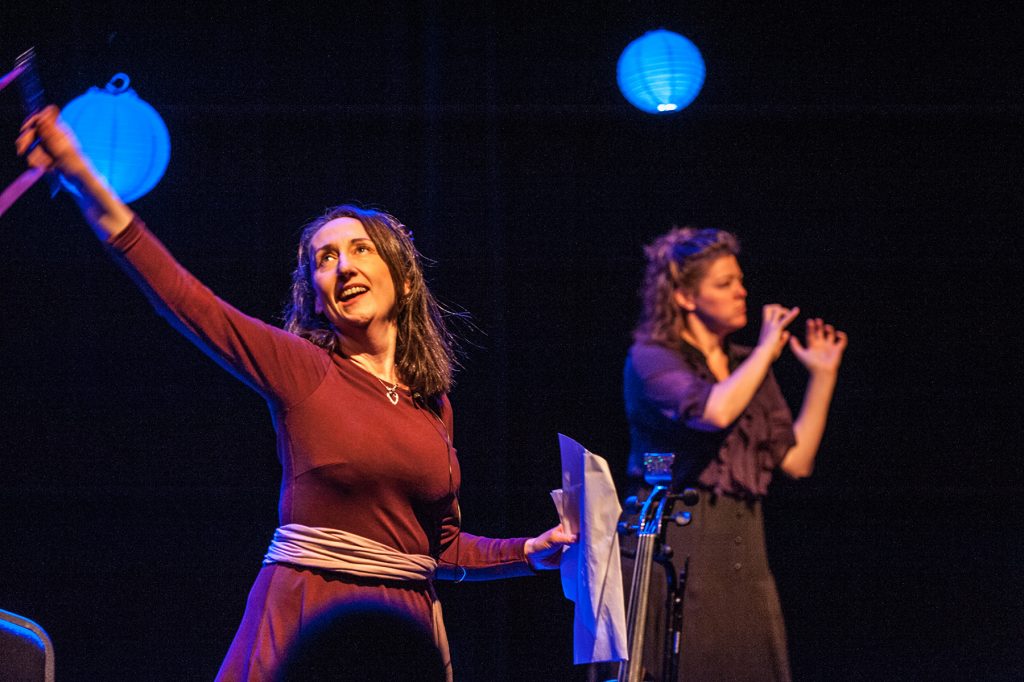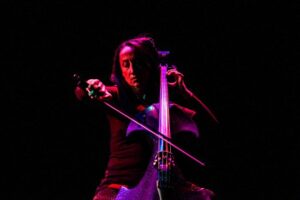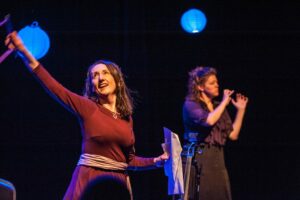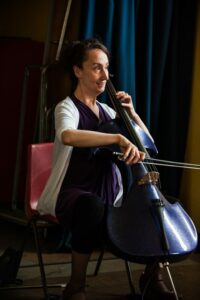
JULIA LEE BARCLAY-MORTON – YOGA, WATER AND REWRITING AUTISM
I interviewed writer Julia Lee Barclay-Morton about her experience of autism. Julia began as an experimental dramatist in New York, moving to the UK to


Interview with electric cellist Jo-anne Cox about her neurodivergent composition Defiant Journey blending music, activism and storytelling – a piece that transcends “the damming label of Borderline Personality Disorder” to “embrace the intensity, reactivity and exquisite sensitivity, that comes with having more powerful emotions than the norm.”
Leslie: Can you tell us about the electric cello, please. How it differs from the conventional cello in terms of sound, playing technique and characteristic repertoire?
Jo-anne: There are many different designs of electric cello that have their own unique characteristics. For example, Bridge Electric Cellos have a full hollow body which gives a fabulous depth of sound and a natural quality. The Yamaha Silent Cellos have a small built in resonating chamber, making them excitingly reactive and have built in reverb options.
When you’re sitting down, the basic playing technique isn’t hugely different to a conventional cello, it’s about adapting to the shape of the instrument and most of the sound coming from an amp. Standing up playing is a whole new technique which takes a lot of time to master.
You can play anything you like on an electric cello; in classical music it is most suitable for classical crossover and anything composed for it specifically. The main thing to understand is that the electric cello is not a substitute for a conventional cello, its best use is when it is respected as a unique instrument in its own right. The sound is a blend of natural and synthetic sound which can be shaped using equalisation (EQ), different models of pre amp, amps and various effect controls.
Leslie: What first drew you to the electric cello? How did you develop your skills on it?
Jo-anne: My first electric cello was a complete impulse buy. A sound engineer accidently kicked my acoustic cello at a gig and that was it, I had just had enough! I was lucky enough to play in the London Breakbeat Orchestra around 2007-2009, that gave me plenty of opportunity to practice my electric, then after that I started improvising and writing my own material, which requires a lot of work to sound any good.
Leslie: Can you describe the range of collaborative work you do, please, including work with Penny Pepper, Ivan Riches and Drake Music?
Jo-anne: I am drawn to collaborations that blend art forms, mix musical genres, bring to light hidden stories, break barriers and contain a strong measure of activism. With Penny Pepper I loved bringing out the rhythms and evoking the atmosphere of her poems, from the rough and ready of Old Cripplegate Town to the dirty smelly shaky London Bus with a broken ramp.
For Ivan Riches’ Surroundings I was part of a group of musicians immersed inside a 360 degree film, projected onto Sue Austin’s 360 degree rig. We improvised to voice recordings of people from Southwark, North Devon and Bavaria talking about their experiences of home disruption and change. The audience could move in and out of the rig, come up close to the musicians or listen from outside.
With Drake Music I’ve worked as equals with musicians using accessible instruments, had my cello connected up with audience interactive foot sensors for the first performance of Planted Symphony and received a great deal of support to develop my career.
It was a joy to be part of Oliver Cross’s Drake Music Commission “The Visitor” a work which effortlessly blended English and Romanian folk music, improvisation, audience participation on iPad, electronic sound, photography and film!
Leslie: How does your ‘Defiant Journey’ show challenge the recovery model of mental health and perceptions of Borderline Personality Disorder?
Jo-anne: In the show the cello reactive lanterns and the cello composition symbolise and embrace the intensity, reactivity and exquisite sensitivity, that comes with having more powerful emotions than the norm – a key feature of what is pathologised in the damning label of Borderline Personality Disorder and what Recovery Model attempts to normalise.
Leslie: Can you tell us how your ‘Defiant Journey’ show works, please.
Jo-anne: A key feature of the show is the radio-controlled lanterns which hang above from the stage. These colour-changing lanterns are triggered by the intensity, length and pitch of notes played on the cello or by the audience playing their own music on iPads. The sound is changed into light via the Dragon Light Box designed for me by creative technologist Charles Matthews.

The Dragon Light Box is a coded Raspberry Pi (a tiny single board computer) inside a box and can be connected to any instrument or voice through a jack lead or microphone. In the full studio theatre production, the lanterns work in harmony with immersive lighting design by David Abra.
Defiant Journey has an area by the stage where audience members can try vibratactile neckpillows and cushions made by David Bobier of Vibrafusion Lab. Internal speakers systems within these items transmit the power of the cello through vibration. The development of the vibratactile items has been generously supported by Help Musicians UK.
The show breaks down barriers between performer and audience. Through the use of technology, the audience contribute to the story. It’s exciting as a performer to respond to the creative output of the audience during a performance.
Defiant Journey emerged as a story whilst pulling together a set of cello compositions for my ACE funded Research and Development project Engage and Interact. The compositions all came about as I was processing real life stuff through the cello – to do with losing a friend, fighting recovery model and privatised medical assessment.
During Engage and Interact I had been experimenting with new ways to engage audiences with live cello. I was very lucky to work with creative technologist Charles Matthews, lighting designer David Abra and Together! 2012 (who generously lent me vibratactile tabards, cushions and a ball made by Disabled artists in East London).
I didn’t experience too many difficulties with the initial development, This was due to excellent access support and project management by Foteini Galanopoulou.
The most scary thing was presenting a show in Stratford Circus Arts Centre when I had no director and all the rehearsal time went on setting up the lighting and technology. It was knowing how hard the gap would be between this first test performance and raising funds to properly develop and tour the show, that made me decide to enjoy every moment on stage.
Leslie: How does the show question traditional models of music.
Jo-anne: Music is sound, music is colour, music is vibration, music is movement and music is a language. Defiant Journey channels the cello into all these, instead of expecting all members of our audience to channel themselves into one means of engagement. There is BSL interpretation of the script and the music. I want to offer more ways into music, opening up to people who are effectively excluded by a traditional model
Leslie: How has neurodivergence helped and hindered your own creative development?

Jo-anne: I experience a lot of issues with distracting thoughts, emotions and feeling overwhelmed. This is really hard to process, feels at times like an inadequacy and constantly impacts on the quality of my cello practice. It makes it hard to be at the standard of cello playing I want to be at and really limits the amount of creative output that I can achieve.
On the plus side people say my music is mesmerising and deeply moving. This is definitely to do with emotional sensitivity, as is my aptitude for creative improvisation. My journey as a neurodivergent artist has led me to exciting cross-art form collaborations where there have been important stories to tell and a strong message to share. It has also led me to use my cello as a platform to support creativity in others.
Note
In response to Covid 19 the Defiant Journey team will be exploring hands-free sensors as an alternative to iPads and will look at ways to use the vibratactile technology with strict safety measures. We are developing and showcasing our flexible tour model in 2021 and the full studio theatre production will tour in 2022. Meanwhile with my wonderful director and dramaturge Kate Lovell, Charles Matthews, and Shipshape marketing I am working on our online project ‘Define Your Journey’. Look out for the first edit coming soon on You Tube.
ABOUT LESLIE TATE’S BOOKS:

I interviewed writer Julia Lee Barclay-Morton about her experience of autism. Julia began as an experimental dramatist in New York, moving to the UK to

I interviewed Gillean McDougall from Glasgow, who edited the collaborative projects Honest Error (on Charles Rennie Mackintosh and his wife Margaret Macdonald) and Writing the

I interviewed French writer Delphine de Vigan, whose book, No et moi, won the prestigious Prix des libraires. Other books of hers have won a clutch

I interviewed Joanne Limburg whose poetry collection Feminismo was shortlisted for the Forward Prize for Best First Collection; another collection, Paraphernalia, was a Poetry Book Society Recommendation. Joanne

I interviewed Katherine Magnoli about The Adventures of KatGirl, her book about a wheelchair heroine, and Katherine’s journey from low self-esteem into authorial/radio success and
| Cookie | Duration | Description |
|---|---|---|
| cookielawinfo-checkbox-analytics | 11 months | This cookie is set by GDPR Cookie Consent plugin. The cookie is used to store the user consent for the cookies in the category "Analytics". |
| cookielawinfo-checkbox-functional | 11 months | The cookie is set by GDPR cookie consent to record the user consent for the cookies in the category "Functional". |
| cookielawinfo-checkbox-necessary | 11 months | This cookie is set by GDPR Cookie Consent plugin. The cookies is used to store the user consent for the cookies in the category "Necessary". |
| cookielawinfo-checkbox-others | 11 months | This cookie is set by GDPR Cookie Consent plugin. The cookie is used to store the user consent for the cookies in the category "Other. |
| cookielawinfo-checkbox-performance | 11 months | This cookie is set by GDPR Cookie Consent plugin. The cookie is used to store the user consent for the cookies in the category "Performance". |
| viewed_cookie_policy | 11 months | The cookie is set by the GDPR Cookie Consent plugin and is used to store whether or not user has consented to the use of cookies. It does not store any personal data. |